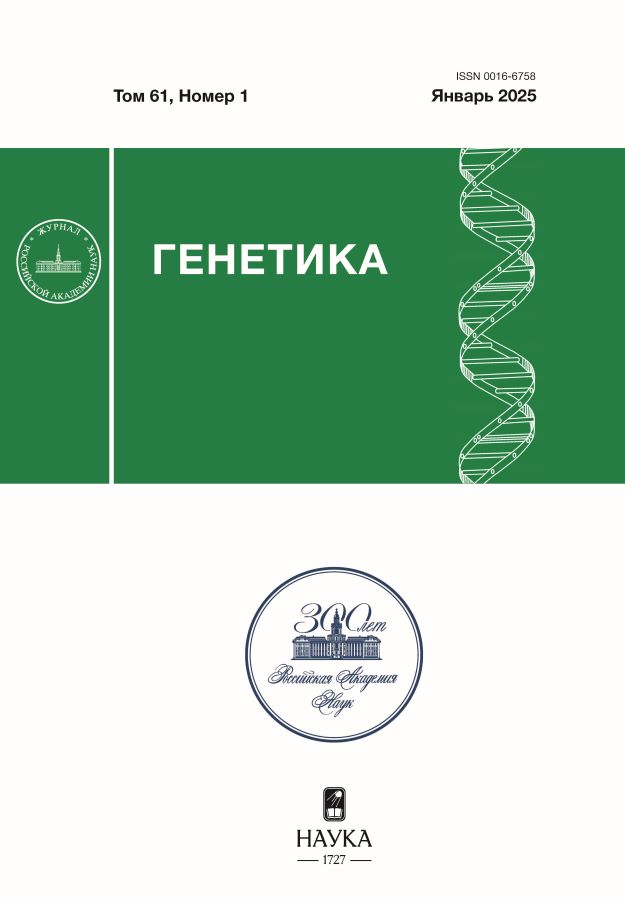Structure of the STR allele pool of the population of kholmogoryk breed bulls, saved in the Komi Republic of the bank of frosed semen
- Autores: Matyukov V.S.1, Leichenko A.S.1, Zharikov Y.А.1, Nikolaev S.V.1
-
Afiliações:
- Institute of Agrobiotechnologies, Federal Research Center Komi Scientific Center, Ural Branch of the Russian Academy of Sciences
- Edição: Volume 61, Nº 1 (2025)
- Páginas: 82-90
- Seção: ГЕНЕТИКА ЖИВОТНЫХ
- URL: https://ruspoj.com/0016-6758/article/view/686169
- DOI: https://doi.org/10.31857/S0016675825010081
- EDN: https://elibrary.ru/VEHBQU
- ID: 686169
Citar
Texto integral
Resumo
Microsatellite polymorphism was studied in 162 purebred Pechora-type bulls of the Kholmogory, Kholmogory, and Holstein breeds, as well as Holstein-Kholmogory crossbreeds. For 15 microsatellite loci, 132 alleles were identified, or 8.8 on average per locus. Of the total number of alleles, 78 (59.1%), or 5.2 alleles per locus on average, occurred with frequencies greater than 0.1 in at least one of the groups of bulls of different genealogy and breed. Twenty-one alleles in 13 loci occurred with frequencies of 0.15 and higher, regardless of the breed, genealogy, and breed of the group. The largest number of alleles was found in the Pechora-Kholmogory-Holstein and Kholmogory-Holstein crossbreeding groups. The maximum genetic distance was established between the crossed Pechora-Kholmogory bulls and Holstein bulls (DN 0.237, FST 0.045). High genetic differentiation of Holstein bulls with crossed and purebred Pechora-type sires of the Kholmogory breed was confirmed by cluster analysis. The genetic difference between the classical Kholmogory breed and the Holstein was lower. Cluster analysis of the results of genotyping by microsatellites of Kholmogory bulls in one array with samples of Holstein animals and Kholmogory-Holstein crosses made it possible to obtain additional information for planning measures to maintain the genetic diversity of the seved herd of purebred Kholmogory cattle.
Palavras-chave
Texto integral
Sobre autores
V. Matyukov
Institute of Agrobiotechnologies, Federal Research Center Komi Scientific Center, Ural Branch of the Russian Academy of Sciences
Autor responsável pela correspondência
Email: nipti38@mail.ru
Rússia, Syktyvkar
A. Leichenko
Institute of Agrobiotechnologies, Federal Research Center Komi Scientific Center, Ural Branch of the Russian Academy of Sciences
Email: nipti38@mail.ru
Rússia, Syktyvkar
Ya. Zharikov
Institute of Agrobiotechnologies, Federal Research Center Komi Scientific Center, Ural Branch of the Russian Academy of Sciences
Email: nipti38@mail.ru
Rússia, Syktyvkar
S. Nikolaev
Institute of Agrobiotechnologies, Federal Research Center Komi Scientific Center, Ural Branch of the Russian Academy of Sciences
Email: nipti38@mail.ru
Rússia, Syktyvkar
Bibliografia
- Матюков В.С., Тырина Ю.О., Кантанен Ю., Столповский Ю.А. Оценка селекционной ценности генофонда местного скота (на примере холмогорской породы) // С.-х. биология. 2013. № 2. С. 19–30.
- Матюков В.С., Жариков Я.А., Зиновьева Н.А. Генетическая история и ценность генофонда исчезающей холмогорской породы // Молочное и мясное скотоводство. 2018. № 2. С. 2–8.
- Резников Ф.И. Новые данные к истории холмогорского скота. Архангельск, 1949. 28 с.
- Шубин П.Н., Котельников В.М. Породное преобразование крупного рогатого скота Коми АССР. Сыктывкар, 1965. 135 с.
- Гагиев Г.И. Характеристика животных нового внутрипородного печорского типа – “ПХ-1” холмогорской породы // Научные основы молочного производства на Севере. Сыктывкар, 1998. С. 56–84.
- Столповский Ю.А., Захаров-Гезехус И.А. Проблема сохранения генофондов доместицированных животных // Вавил. журн. генетики и селекции. 2017. Т. 21. № 4. С. 477–486. https://doi.org/10.18699/VJ17.266
- Demir E., Balcioğlu M.S. Genetic diversity and population structure of four cattle breeds raised in Turkey using microsatellite markers // Czech. J. Animal Sci. 2019. V. 64. № 10. Р. 411–419. https://doi.org/10.17221/62/2019-CJAS
- Saravanan K.A., Panigrahi M., Kumar H. et al. Genome-wide assessment of genetic diversity, linkage disequilibrium and haplotype block structure in Tharparkar cattle breed of India // Animal Biotechnology. 2020. V. 33. № 1. Р. 1–15. https://doi.org/10.1080/10495398.2020.1796696
- Pritchard J.K., Wen X., Falush D. Documentation for structure software: Version 2.3. Software from http://pritch.bsd.uchicago.edu/structure.html
- Галинская Т.В., Щепетов Д.М., Лысенков С.Н. Предубеждения о микросателлитных исследованиях и как им противостоять // Генетика. 2019. T. 55. № 6. С. 617–632. https://doi.org/10.1134/S0016675819060043
- Матюков В.С., Жариков Я.А., Канева Л.А. Анализ аллелофонда полутонкорунных овец печорской популяции с помощью STR-маркеров // Генетика. 2023. T. 59. № 7. С. 843–849. https://doi.org/10.31857/S0016675823060103
- Peakall R., Smouse P.E. GenAlEx 6.5: Genetic analysis in Excel. Population genetic software for teaching and research-anupdate // Bioinformatics. 2012. V. 28. P. 2537–2539.
- Hall S.J.G. Genetic differentiation among Livestock breeds-values for Fst // Animals. 2022. V. 12. № 9. https://doi.org/10.3390/ani12091115
- Kalinowski S.T. Evolutionary and statistical properties of three genetic distances // Mol. Ecol. 2002. V. 11. № 8. Р. 1263–1273. https://doi.org/10.1046/j.1365-294X.2002.01520.x
- Кузнецов В.М. Сравнение методов оценки генетической дифференциации популяций по микросателлитным маркерам // Аграрная наука Евро-Северо-Востока. 2020. Т. 21. № 2. С. 169–182. https://doi.org/10.30766/2072-9081.2020.21.2.169-182
- Николаев С.В., Ялуга В.Л. Сравнительная генетическая характеристика микросателлитного профиля голштинизированных и чистопородных холмогорских быков // Аграрная наука. 2023. № 7. С. 58–62. https://doi.org/10.32634/0869-8155-2023-372-7-58-62
- Волкова В.В., Романенкова О.С., Денискова Т.Е. и др. Характеристика аллелофонда холмогорской породы крупного рогатого скота с использованием STR-маркеров // Молочное и мясное скотоводство. 2019. № 7. С. 3–7.
- Киселёва Т.Ю., Подоба Б.Е., Заблудский Е.Е. и др. Анализ 30 микросателлитных маркеров у шести локальных популяций крупного рогатого скота // С.-хоз. биология. 2010. № 6. С. 20–25.
- Meng-Hua Li., Tapio I., Villkki J. et al. The genetic structure of cattle populations (Bos taurus) in northern Eurasia and the neighbouring. Near Eastern regions: Implications for breeding strategies and conservation // Mol. Ecol. 2007. V. 16. № 18. Р. 3839–3853. https://doi.org/10.1111/j.1365-294X.2007.03437.x
- Kantanen J., Edwards C.J., Bradley D. et al. Maternal and paternal genealogy of Eurasian taurine cattle (Bos taurus) // Heredity. 2009. V. 103. № 5. Р. 404–415. https://doi.org/10.1038/hdy.2009.68
Arquivos suplementares












